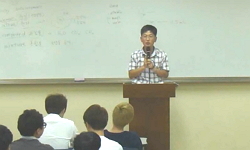The main aim of doping DNA lattices with lanthanide ions (Ln-DNA complex) is to change the physical functionalities for specific target applications such as electronics and biophotonics. LneDNA complexes based on a double-crossover DNA building block ...
http://chineseinput.net/에서 pinyin(병음)방식으로 중국어를 변환할 수 있습니다.
변환된 중국어를 복사하여 사용하시면 됩니다.
- 中文 을 입력하시려면 zhongwen을 입력하시고 space를누르시면됩니다.
- 北京 을 입력하시려면 beijing을 입력하시고 space를 누르시면 됩니다.
https://www.riss.kr/link?id=A104339141
- 저자
- 발행기관
- 학술지명
- 권호사항
-
발행연도
2017
-
작성언어
English
- 주제어
-
등재정보
KCI등재,SCOPUS,SCIE
-
자료형태
학술저널
-
수록면
1409-1414(6쪽)
-
KCI 피인용횟수
3
- 제공처
-
0
상세조회 -
0
다운로드
부가정보
다국어 초록 (Multilingual Abstract)
The main aim of doping DNA lattices with lanthanide ions (Ln-DNA complex) is to change the physical functionalities for specific target applications such as electronics and biophotonics. LneDNA complexes based on a double-crossover DNA building block were fabricated on glass using a substrate-assisted growth method. We demonstrated the structural stability of LneDNA complexes as a function of Ln ion concentration by the atomic force microscopy. The Ln ion doping in DNA lattices was examined using a chemical reduction process, and the electrical characteristics of LneDNA complexes were tested using a semiconductor parameter analyzer. The structural phase transition of DNA lattices from the crystalline to amorphous phases occurred at a certain critical concentration of each Ln ion. Ln ions in DNA lattices are known to be intercalated between the base pairs and bound with phosphate backbones. When DNA lattices are properly doped with Ln ions, LneDNA complexes revealed the complete deformation with chemical reduction process by ascorbic acid. The current increased up to a critical Ln ion concentration and then decreased with further increasing Ln ions. LneDNA complexes will be useful in electronics and photonics because of their unique physical characteristics.
참고문헌 (Reference)
1 N. C. Seeman, 79 : 65-87, 2010
2 B. Xu, 4 : 1105-1108, 2004
3 E. Winfree, 394 : 539-544, 1998
4 Y. He, 452 : 198-201, 2008
5 P. W. K. Rothermund, 440 : 297-302, 2006
6 O. Gullu, 254 : 5175-5180, 2008
7 V. Bhalla, 4 : 442-445, 2003
8 A. J. Steckl, 1 : 3-5, 2007
9 H. Yan, 301 : 1882-1884, 2003
10 A. Rakitin, 86 : 3670-3673, 2001
1 N. C. Seeman, 79 : 65-87, 2010
2 B. Xu, 4 : 1105-1108, 2004
3 E. Winfree, 394 : 539-544, 1998
4 Y. He, 452 : 198-201, 2008
5 P. W. K. Rothermund, 440 : 297-302, 2006
6 O. Gullu, 254 : 5175-5180, 2008
7 V. Bhalla, 4 : 442-445, 2003
8 A. J. Steckl, 1 : 3-5, 2007
9 H. Yan, 301 : 1882-1884, 2003
10 A. Rakitin, 86 : 3670-3673, 2001
11 X. Wang, 3 : 5150-5154, 2015
12 J. Sharma, 323 : 112-116, 2009
13 R. Mehta, 2 : 6236-6248, 2014
14 K. Keren, 302 : 1380-1382, 2003
15 H. T. Maune, 5 : 61-65, 2009
16 S. Hamada, 48 : 6820-6823, 2009
17 J. Lee, 50 : 9145-9149, 2011
18 S. R. Dugasani, 6 : 2974-2979, 2014
19 A. Kulkarni, 3 : 2062-, 2013
20 S. R. Dugasani, 26 : 275604-, 2015
21 S. R. Dugasani, 3 : 1819-, 2013
22 J. S. Lee, 71 : 162-168, 1993
23 M. Kenji, 7040 : 70400Qe9-, 2008
24 H. Kino, 73 : 2089-2092, 2004
25 S. S. Alexandre, 73 : 205112-, 2006
26 H. Matsui, 79 : 235201-, 2009
27 J. Lee, 8 : 374-377, 2012
28 S. Wu, 61 : 1125-1129, 2007
29 Y. Zhang, 89 : 198102-, 2002
30 H. Watanabe, 79 : 2462-, 2001
31 H. W. Fink, 398 : 407-410, 1999
32 A. Y. Kasumov, 291 : 280-282, 2001
33 S. H. Tseng, 100 : 1042-1048, 2011
34 T. Liu, 127 : 10160-10161, 2005
35 E. Macia, 17 : 3002-3007, 2006
36 D. Porath, 403 : 635-638, 2000
37 R. Dong, 5 : 1431-1436, 2010
38 H. Liu, 115 : 22547-22556, 2011
39 P. Yin, 321 : 824-826, 2008
동일학술지(권/호) 다른 논문
-
- 한국물리학회
- K. Pramod
- 2017
- KCI등재,SCOPUS,SCIE
-
- 한국물리학회
- M. Manhas
- 2017
- KCI등재,SCOPUS,SCIE
-
- 한국물리학회
- 임주원
- 2017
- KCI등재,SCOPUS,SCIE
-
- 한국물리학회
- Ambrish Kumar Srivastava
- 2017
- KCI등재,SCOPUS,SCIE
분석정보
인용정보 인용지수 설명보기
학술지 이력
| 연월일 | 이력구분 | 이력상세 | 등재구분 |
|---|---|---|---|
| 2023 | 평가예정 | 해외DB학술지평가 신청대상 (해외등재 학술지 평가) | |
| 2020-01-01 | 평가 | 등재학술지 유지 (해외등재 학술지 평가) |  |
| 2008-01-01 | 평가 | 등재학술지 선정 (등재후보2차) |  |
| 2007-01-01 | 평가 | 등재후보 1차 PASS (등재후보1차) |  |
| 2003-01-01 | 평가 | 등재후보학술지 선정 (신규평가) |  |
학술지 인용정보
| 기준연도 | WOS-KCI 통합IF(2년) | KCIF(2년) | KCIF(3년) |
|---|---|---|---|
| 2016 | 1.8 | 0.18 | 1.17 |
| KCIF(4년) | KCIF(5년) | 중심성지수(3년) | 즉시성지수 |
| 0.92 | 0.77 | 0.297 | 0.1 |






 KCI
KCI






